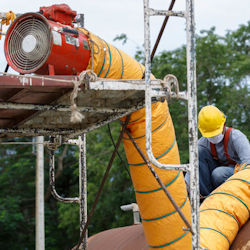Control Measures for Welding or Cutting Containers
Used Containers
Do not weld, cut, or perform other hot work on used drums, barrels, tanks or other containers until you clean them.
Drum Explodes During Welding
- Clean them thoroughly to make absolutely certain there are no flammable materials present or any substances such as greases, tars, acids, or other materials which when subjected to heat, might produce flammable or toxic vapors.
- Disconnect or blanket any pipelines or connections to the drum or vessel.
Venting and Purging
Vent all hollow spaces, cavities or containers to permit air or gases to escape before preheating, cutting or welding. You should purge with inert gas.
Here are some strategies for reducing exposure while welding.
- OSHA's standard, 1910.1200, Hazard Communication, requires employers to provide information and training for workers on hazardous materials in the workplace.
- Welding surfaces should be cleaned of any coating that could potentially create toxic exposure, such as solvent residue and paint.
- Workers should position themselves to avoid breathing welding fumes and gases. For example, workers should stay upwind when welding in open or outdoor environments.
- In work areas without ventilation and exhaust systems, use natural drafts along with proper positioning to keep fumes and gases away from welders and others.
- Keep fume hoods, fume extractor guns and vacuum nozzles close to the plume source to remove the maximum amount of fumes and gases. Portable or flexible exhaust systems can be positioned so that fumes and gases are drawn away from the welder.
- Consider substituting a lower fume-generating or less toxic welding type or consumable.
- Do not weld in confined spaces without forced-air ventilation. Natural ventilation is not adequate.
- Use respiratory protection if work practices and ventilation do not reduce exposure to safe levels.
Knowledge Check Choose the best answer for the question.
3-9. What must be done while welding in confined spaces to limit exposure to gases and fumes?
You forgot to answer the question!

